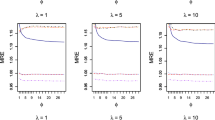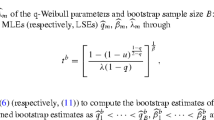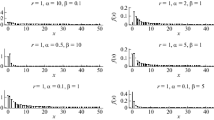Abstract
The negative binomial (NB) distribution is of interest in various application studies. New closed-form efficient estimators are proposed for the two NB parameters, based on closed-form \(\sqrt{n}\)-consistent estimators. The asymptotic efficiency and normality of the new closed-form efficient estimators are guaranteed by the theorem applied to derive the new estimators. Since the new closed-form efficient estimators have the same asymptotic distribution as the maximum likelihood estimators (MLEs), these are denoted as MLE-CEs. Simulation studies suggest that the MLE-CE of dispersion parameter r performs better than its MLE and the method of moments estimator (MME) for some parameter ranges. The MLE-CE of the probability parameter p exhibits the best performance for relatively large p values, where the positive-definite expected Fisher information matrix exists. MLE performs better than MME in this parameter space. The MLE-CE is over 200 times faster than the MLE, especially for large sample sizes, which is good for the big data era. Considering the estimated accuracy and computing time, MLE-CE is recommended for small r values and large p values, whereas MME is recommended for other conditions.





Similar content being viewed by others
References
Adamidis K (1999) An EM algorithm for estimating negative binomial parameters. Aust N Z J Stat 41(2):213–221
Al-Khasawneh MF (2010) Estimating the negative binomial dispersion parameter. Asian J Math Stat 3(1):1–15
Anscombe FJ (1949) The statistical analysis of insect counts based on the negative binomial distribution. Biometrics 5:165–173
Best DJ, Gipps PG (1974) An improved gamma approximation to the negative binomial. Technometrics 16:621–624
Clark SJ, Perry JN (1989) Estimation of the negative binomial parameter \(k\) by maximum quasi-likelihood. Biometrics 45:309–316
Ehrenberg A (1988) Repeat-buying: facts, theory and applications. Oxford University Press, New York
Essa M, Sayed T (2018) Traffic conflict models to evaluate the safety of signalized intersections at the cycle level. Transp Res Part C 89:289–302
Fisher RA (1941) The negative binomial distribution. Ann Eugen 11:182–187
Grandell J (1997) Mixed Poisson processes. Chapman & Hall, London
Haldane JBS (1941) The fitting of binomial distributions. Ann Eugen 11:179–181
Lawless JF (1987) Negative binomial and mixed Poisson regression. Can J Stat 15:209–225
Lehmann EL, Casella G (2006) Theory of point estimation, 2nd edn. Springer, New York
Lundberg O (1964) On random processes and their application to sickness and accident statistics. Almquist and Wiksells, Uppsala
Robertson B, Fung T, Weber N (2013) An alternative estimator for the shape parameter in the negative binomial distribution. Math Sci 38:34–42
Ross GJS, Preece DA (1985) The negative binomial distribution. J R Stat Soc Ser D (Stat) 34(3):323–335
Savani V, Zhigljavsky AA (2006) Efficient estimation of parameters of the negative binomial distribution. Commun Stat Theory Methods 35(5):767–783
Srivastava HM, Choi J (2012) Zeta and q-Zeta functions and associated series and integrals. Elsevier, Amsterdam
Yee T, Moler C (2019) VGAM: vector generalized linear and additive models, R package version 1.1-2. https://www.stat.auck.land.ac.nz/yee/VGAM
Zhang Y, Ye Z, Lord D (2007) Estimating dispersion parameter of negative binomial distribution for analysis of crash data: bootstrapped maximum likelihood method. Transp Res Rec 2019(1):15–21
Zhang X, Liu P, Chen Y, Bai L, Wang W (2014) Modeling the frequency of opposing left-turn conflicts at signalized intersections using generalized linear regression models. Traffic Inj Prev 15(6):645–651
Acknowledgements
The corresponding author’s research was supported by the Basic Science Research Program through the National Research Foundation of Korea (NRF) funded by the Ministry of Education (2018R1D1A1B07045603), and a National Research Foundation of Korea (NRF) grant funded by the Korean government (MSIT) (2021R1A4A5032622).
Author information
Authors and Affiliations
Corresponding author
Additional information
Publisher's Note
Springer Nature remains neutral with regard to jurisdictional claims in published maps and institutional affiliations.
Supplementary Information
Below is the link to the electronic supplementary material.
Appendices
Appendix A
The assumptions for Theorem 1:
- (A1):
-
The distributions of the observations are distinct;
- (A2):
-
The distributions have common support;
- (A3):
-
The observations are \(\textbf{X}=\left( X_1,\ldots , X_n\right) \), where the \(X_i\)s are i.i.d. with probability density or probability mass \(f(x|{\varvec{\theta }})\) which is assumed to be continuous or discrete at x;
- (A4):
-
There exists an open subset \(\omega \) of \(\Omega \) containing the true parameter point \({\varvec{\theta }}^0\) such that for almost all x, the density \(f(x|{\varvec{\theta }})\) admits all third derivatives \({\partial ^3\over \partial \theta _j \partial \theta _k\partial \theta _l}f(x|{\varvec{\theta }})\) for all \({\varvec{\theta }}\) in \(\omega \);
- (A5):
-
The first and second logarithmic derivatives of f satisfy the equations
$$\begin{aligned} E_{\varvec{\theta }}\left[ {\partial \over \partial \theta _j} \log f( X |{\varvec{\theta }})\right] =0\text { for }j=1,\ldots ,s, \end{aligned}$$and
$$\begin{aligned} {\mathcal {I}}_{jk}({\varvec{\theta }})= & {} E_{\varvec{\theta }} \left[ {\partial \over \partial \theta _j}\log f( X |{\varvec{\theta }}) \cdot {\partial \over \partial \theta _k}\log f( X |{\varvec{\theta }})\right] \\= & {} E_{\varvec{\theta }}\left[ -{\partial ^2\over \partial \theta _j\partial \theta _k} \log f( X |{\varvec{\theta }})\right] ; \end{aligned}$$ - (A6):
-
Assume that the \({\mathcal {I}}_{jk}({\varvec{\theta }})\) are finite and that the matrix \({\mathcal {I}}\) is positive definite for all \({\varvec{\theta }}\) in \(\omega \), and hence that the score statistics \({\partial \over \partial \theta _j}\log f(x|{\varvec{\theta }})\) for \(j=1,\ldots ,s\), are affinely independent with probability 1;
- (A7):
-
Suppose that there exist functions \(M_{jkl}(x)\) such that
$$\begin{aligned} \left| {\partial ^3\over \partial \theta _j\partial \theta _k\partial \theta _l} f(x|{\varvec{\theta }})\right| \le M_{jkl}(x) \text { for all } {\varvec{\theta }}\in \omega , \end{aligned}$$where \(m_{jkl}(x)=E_{{\varvec{\theta }}^0}\left[ M_{jkl}(X) \right] <\infty \) for all j, k, l.
Appendix B
Elements of the new closed-form efficient estimators of parameters \({\varvec{\theta }}_*=(r,\mu )\) in the Sect. 4:
Rights and permissions
Springer Nature or its licensor (e.g. a society or other partner) holds exclusive rights to this article under a publishing agreement with the author(s) or other rightsholder(s); author self-archiving of the accepted manuscript version of this article is solely governed by the terms of such publishing agreement and applicable law.
About this article
Cite this article
Zhao, J., Kim, HM. New closed-form efficient estimators for the negative binomial distribution. Stat Papers 64, 2119–2135 (2023). https://doi.org/10.1007/s00362-022-01373-1
Received:
Revised:
Accepted:
Published:
Issue Date:
DOI: https://doi.org/10.1007/s00362-022-01373-1




